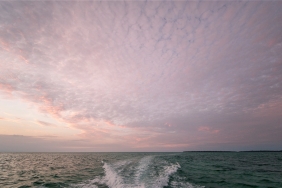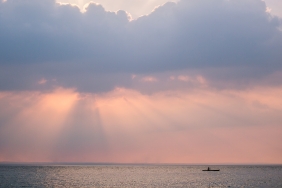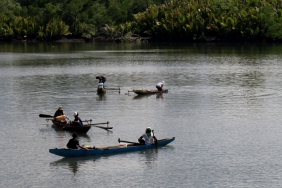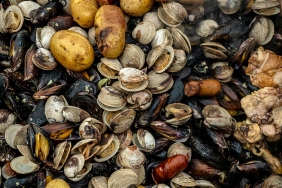BIG POTENTIAL OF SMALL LABENGKI
By: Nisa Syahidah (WWF-Indonesia)
Dinggi docked slowly to this island, which from afar looked like a mother turtle, facing a small coral island that resembled a turtle hatchling. Funny. I feel like squealing with excitement when, not even far from the shore, I see a slope of colorful coral reefs. The white sand is soft and the water is clear - and cold. Welcome to Little Labengki Island.
The name Labengki is actually familiar to travelers. The television show My Trip My Adventure once covered the beauty of Labengki Besar - the name of the island opposite this small island, Labengki Kecil. Both are part of the Lasolo Bay Nature Park (TWA), Lasolo Islands District, North Konawe Regency.
There is no signal in Labengki Village. Electricity from the generator only runs from 6 p.m. to 11 p.m. Since 2011, the residents of the three hamlets of Labengki Village have inhabited only a small part of the island. There are less than 500 of them, the majority of whom are Bajo, followed by Muna, Buton, Tolaki and Bugis.
"The name Labengki is from the Buton language. 'La' is 'there', 'bengki' is 'jar' - a historical relic," says the art teacher at Labengki Elementary School. Surrounded byreefs on the west, east and north sides of the island, the people of Labengki live on an island full of potential, especially in terms of marine tourism. "Here, tourists come maybe once a month," he continued. "They usually come to go to Labengki Besar Island."
Labengki Kecil is like a gateway to Teluk Cinta and Pasir Panjang - two famous tourism spots on the uninhabited island of Labengki Besar. A few small boats marked Labengki Wisata can be seen docked on the other side of the island. But, Labengki Kecil is actually much more than that.
"Kaka, shall we go to Swimming Pool Cave now? Let's go!" In no time at all, out-of-school boys surrounded us, including the Labengki Village Chief's son. "Let's go to the lighthouse, too!" they called out, clustered in groups of more than ten.
We walked to Swimming Pool Cave, a cave with a saltwater pool inside. Climbing up the rock stairs a bit, we reached the cave door. It was quite dark in there, while turning on the headlamp, I dipped my feet in the light tosca-colored water.
Marble-like stones are found around the cave. Mrs. Rahma (Halu Oleo University) said, it is likely that these rocks and caves were once under the sea.
We continued walking around the island, along the beach to the lighthouse. Observing the various activities of the residents in the late afternoon - swimming, fetching well water, bathing, building boats, cleaning caught fish, and drying fish.
We didn't get to go inside the lighthouse, but the walk uphill to this place was beautiful. After all, Labengki Kecil is more than just a gate. Little Labengki is a destination in itself.





